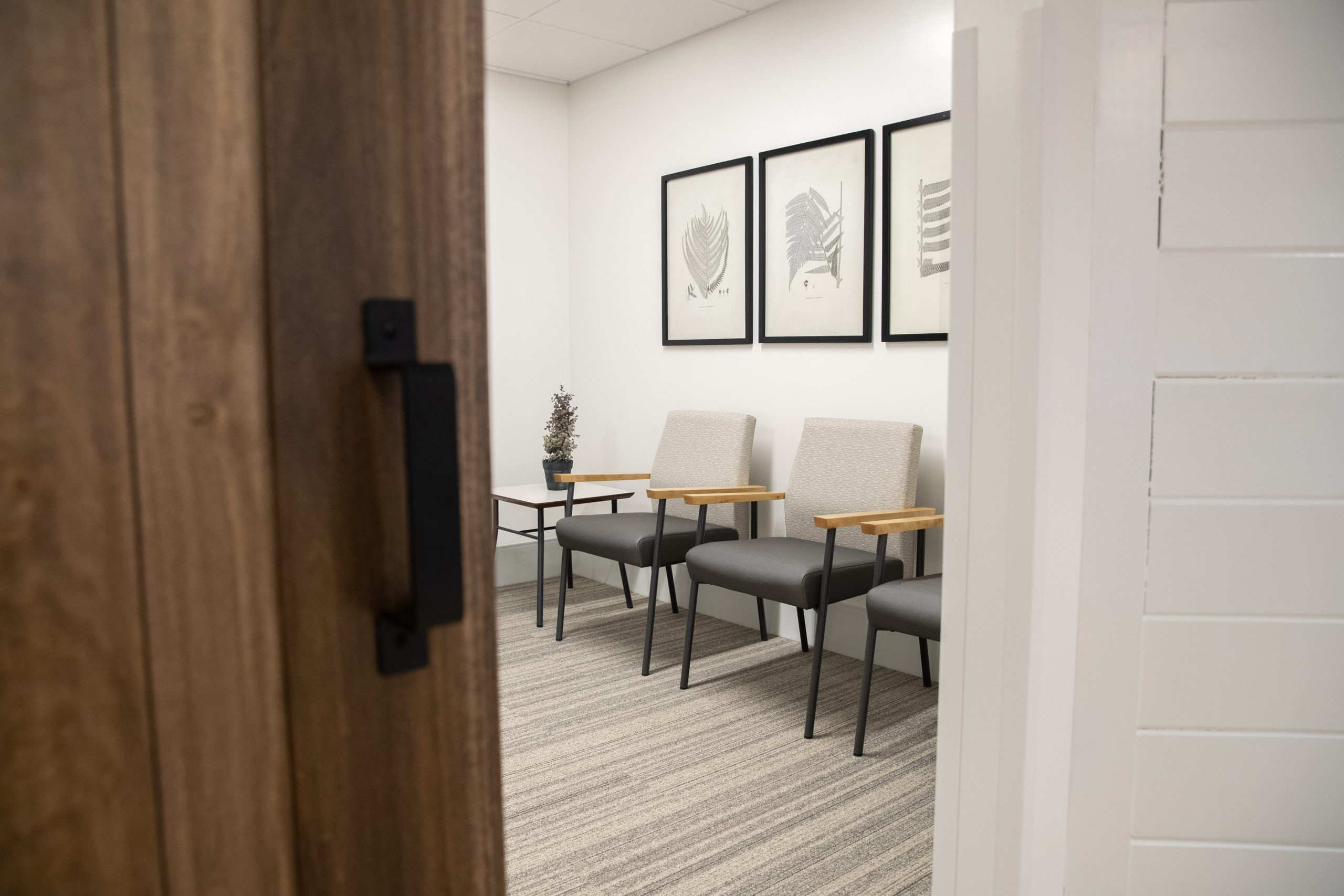
Signature
Mohs Surgery
Tour our Mohs Micrographic & Reconstructive Surgery Suite
What is Mohs Surgery?
Mohs surgery is the gold standard treatment for non-melanoma skin cancers due to its ability to deliver the highest possible cure rate while removing the smallest amount of healthy tissue. The procedure is named for Dr. Frederic E. Mohs who developed the technique in 1938, but the procedure has advanced significantly over time. Mohs surgery is performed in the office under local anesthesia using lidocaine numbing shots without the need for being put to sleep. Frozen tissue samples are processed and analyzed to confirm that a skin cancer has been entirely removed prior to same-day reconstruction of the wound. Tissue is analyzed in a way that allows the surgeon to look at 100% of the edges of the tissue around the skin cancer. As a result, the surgeon is able to remove the smallest possible amount of healthy tissue around the skin cancer while being certain that the cancer has been entirely removed.
How does Mohs Surgery work?
During Mohs surgery, the same physician serves as both a surgeon who removes the skin cancer and a pathologist who analyzes tissue specimens to confirm that the cancer has been entirely removed. The surgeon first removes any visually obvious tumor and then removes a thin 1–2-millimeter layer of skin around and underneath the tumor. This tissue is then taken to the lab where it is frozen, stained, and put on a microscope slide. The surgeon then examines the slide for any remaining tumor. If any remaining tumor is found in this sample, the surgeon will remove another 1-2-millimeter layer of skin from the area where the tumor is still present. This process is repeated until the margins around the tumor are confirmed to be completely clear. Once the tumor has been entirely removed, the surgeon will discuss the best plan for reconstruction. The reconstructive approach depends on many factors, including the location and size of the wound, a patient’s medical history, and the patient’s goals and priorities. Reconstructive options often include a linear repair, flaps, skin grafts, or leaving the wound to heal in on its own.
What cancers are treated with Mohs Surgery?
Mohs surgery is most commonly performed for basal cell carcinoma (BCC) and squamous cell carcinoma (SCC) skin cancers, but Mohs can be used to treat a variety of other skin cancers as well.
What can I expect the day of my procedure?
On the day of your procedure, you can eat, drink, and take all of your normal medications. You do not have to have a driver unless your procedure will be around the eye or on the upper nose due to potential swelling and bandages that can obstruct vision. Our staff will begin by confirming your medical history and checking your vital signs. The surgeon will then confirm the site of your skin cancer and answer any questions you have about the procedure. The surgical site will then be prepared with antiseptic solution and you will be given local anesthesia injections (numbing shots). Once the local anesthesia has taken effect, the surgeon will remove any obvious skin cancer and a layer of tissue for processing in the lab. You will then wait for 15-60 minutes while your tissue is processing. Processing time depends on the size of the specimen and quality of the tissue. If any remaining cancer is found, the surgeon will remove an additional layer of tissue from the area where cancer is still present. This tissue will then be analyzed, which will require additional processing time. Once your cancer is confirmed to be clear, your surgeon will go over options for reconstruction and then repair your wound. At the end of your procedure, your wound will be cleaned and bandaged and you will receive verbal and written wound care instructions. Overall, you should expect for your procedure to take 2-4 hours.
What can I expect with my recovery after my procedure?
Most patients will have a rapid and seamless recovery after Mohs surgery. After your surgery, our staff will provide verbal and written wound care instructions. You will leave with a pressure bandage that will remain in place for 24-48 hours following surgery. Once this bandage is removed, you will clean the wound with a dilute vinegar solution and keep the wound moist with Vaseline. Following surgery, any activity that will increase blood pressure should be avoided for the first 48 hours due to the risk of bleeding. For wounds in areas such as the torso, arms, legs, hands, or feet, you should avoid heavy lifting and vigorous exercise for 3 weeks to allow for healing and to avoid popping stitches. You should not expose the wound to pool, lake, or ocean water for 3 weeks following surgery. Many patients will only have dissolvable sutures that do not need to be removed. Sutures that do require removal on the head and neck are typically removed 5-7 days after surgery while sutures on the torso, arms, or legs are typically removed 14 days after surgery. The cosmetic and functional outcome of the surgery depends on the size and location of the tumor, a patient’s other medical problems, and the quality and consistency of wound care performed by the patient. Most patients are pleased with their results within a month of their surgery, but scars typically continue to improve up to one year after surgery.
I take a blood thinner. Do I need to stop it before surgery?
We recommend that all prescribed medications, including blood thinners, be continued before, during, and after Mohs surgery. Medical studies have shown that the risks of discontinuing blood thinners are greater than the risk of continuing to take them through surgery.
Will I need antibiotics before and/or after surgery?
Most patients do not need antibiotics before or after surgery. The rate of infection following Mohs surgery is less than 1%. Please let our staff know if you have a history of a heart issue such as a congenital heart defect, prosthetic valve, history of endocarditis, or a prosthetic joint replacement within the past two years.
Will I have a scar?
Any procedure that involves an incision in the skin will leave a scar. Our goal is always to restore function and provide the best possible aesthetic outcome. Appearance of scars following Mohs surgery is dependent on many factors, including the location and extent of surgery and the quality and consistency of wound care. The majority of patients are very satisfied with their reconstructive outcomes.
Do I need a driver?
Most patients are able to drive after Mohs surgery, but if your surgical site is around the eye, upper part of the nose, or on your lower leg or foot, it is best to have a driver with you.
I have a melanoma and my doctor told me that I need “Slow Mohs.” What is that and how is it different from regular Mohs surgery?
Slow Mohs (Staged Excision) is a procedure commonly performed by Mohs surgeons to treat melanoma in situ (surface-level melanoma) in cosmetically sensitive areas such as the head and neck. This procedure involves a minimum of two visits. In the first visit, strips of skin are removed from around the outside of the tumor and sent off to an outside dermatopathologist for analysis, rather than analyzing tissue while the patient waits in the office as with regular Mohs surgery. (Special stains are often required for thorough analysis of melanoma specimens vs. basal and squamous cell skin cancer, which can easily be stained in the office.) If all of the strips are clear, the patient comes back for reconstruction at their second visit. If any of the strips are found to contain additional tumor, additional strips are removed at the second visit, which are then sent off for analysis.
Hilliard
P: (614) 777-1200
F: (614) 777-1294
Monday-Friday 8:00AM-5:00PM
3853 Trueman Court
Hilliard, OH 43026
Lewis Center
P: (614) 777-1200
F: (614) 777-1294
Monday-Friday 8:00AM-5:00PM
25 Hidden Ravines Drive
Powell, OH 43065
